News
Pruning Again December 7, 2023 11:47
Pruning is the most important yearly vineyard job. Pruning is on my mind and what my body is doing this time of year.
 So I have to tell you about pruning. I am consumed with pruning. It is my favorite job. It is essential as the foundation for the next vintage. Great wines are built on decisions made while pruning.
So I have to tell you about pruning. I am consumed with pruning. It is my favorite job. It is essential as the foundation for the next vintage. Great wines are built on decisions made while pruning.
If not pruned a grapevine becomes a tangled mess of canes and leaves. Clusters of fruit can be found hidden in the leaves, but they are small disorderly and bland tasting.
If you are going to make wine from a grapevine, then pruning it is essential. So this is what you would do.

As days get shorter and colder the vines go dormant. Leaves turn bright colors from grape pigment and fall into the winter grass. Long bare woody canes from last year’s growth remain. Now in December pruning season starts. There is no rush, but this job needs to be completed before the vines start waking up in April.

While pruning you chose to work with only the healthiest canes that grew last season. Other canes and growth are completely cut away. The remaining chosen canes have dozens of small firm buds That cane is cut back to leave just one or two of those buds. Each one of those buds will give you one or two ripe grape clusters 9 months from now.

Pruning 101
1. Pull out your shears
2. See and study how the vine grew last year.
3. Decide how you what you want the vine to grow next year.
4. Start cutting to make it happen.
This is your presence. You don't think of anything else.



47 Years of Memories. A Pictoral July 4, 2023 16:00
47 years as Frick Winery this year 2023.

Crusher and equipment ready for very first crush. 1976



Judith Gannon and Bill Frick. 1978

Introduced the Cinsaut grape variety as a varietal. 1991

Messiest crush ever. But it was fun. 2001


Iconic water tower in Estate Owl Hill blows down during 1994 storm.


Special Events were fun.


Winter Wineland, Wineroad.
Pets at the tasting room.


Luna Lucia


Madison C 3

I love making wine. Also having it purchased and loaded into customer's cars.

Some of the wines I've made.
CINSAUT December 31, 2021 11:30
A delicious Rhône grape variety bottled as a varietal. Updated1/4/24
Cinsaut vines have been in California for centuries. Until recently known by the synonym Black Malvoisie. Before the 1970’s most grape varieties were mixed and blended. Cinsaut was not used for a stand-alone wine. You never heard the name. Varietal wines were uncommon.
I made my first of Cinsaut wine in 1991. My intent was for blending, as was the norm. When I tasted this 100% batch I fell in love immediately. It was so beautiful and delicious. That wine deserved to stand alone as a varietal. Now I have been making 100% varietal cinsaut for 33 years. It has become an old favorite friend to me and many of my customers. Every vintage has been consistently spectacular. The grape has flavors and balance that are compatible with my traditional hands-off winemaking practices.
My grapes now come from Estate Owl Hill Vineyard, an acre block of 33 year old vines living on hillsides of rocky soil. Clusters have juicy, distinctively large, oval berries that are dusty purple color. Being well balanced with semi-tart acidity and soft tannin make for a delicious wine.
Cinsaut is not a common variety. Only 10 acres are planted in Sonoma County. This compares to over 13,000 acres of Cabernet Sauvignon in the County.
 Classic Cinsaut grape cluster.
Classic Cinsaut grape cluster.
The wine is delicious. I say "beautiful". Cinsaut is a friendly wine. It approaches you with lush fruit aromas and with a sip brings on complexity of more red fruit flavors. Soft restrained tannins and crisp acids lead to a long soft finish with a little nutmeg spice. This character allows you to pair the wine with a wide range of foods, from vegetarian to fish to steak.
Pair with: roast turkey, summer fruit salad, cambozola cheese, pasta primavera, BBQ chicken, spring roles, eggplant parmigiano, salmon, hummus, halibut, quail, guinea fowl, duck comfit, samosas, pizza, red curry, matar paneer, squab, ribeye steak with baked potato
Cinsaut or Cinsault?

You will see the grape name most commonly spelled two different ways; Cinsaut and Cinsault. The government label approval for my first bottling was rejected because of my Cinsault spelling. I had already printed the label so I was lucky to get a one-time dispensation. I was instructed by the authorities not to use this spelling again.
 My first Cinsault label from 1991
My first Cinsault label from 1991
So I now use the spelling "cinsaut" to comply with TTB regulations. TTB is the federal agency that governs wine in the USA. Every wine label in the country must be approved and certified by this agency.
TTB has a comprehensive list of allowed grape variety spelling. This is the section of that list that includes cinsaut.

No matter what the spelling. This grape makes a beautiful wine.
You can view my current release cinsaut wine at Frick Wine Shop
Frick Winery. A little Local History. August 21, 2021 22:13
There are two official California Historical Landmarks within a few miles of Frick Winery. You could drive past and easily miss them so I present them here.
Italian Swiss Colony
Here in 1881 Italian Swiss immigrants established an agricultural colony. Choice wines, produced from grape plantings from the Old World, soon brought wide acclaim. By 1905, ten gold medals were awarded these wines at international competitions.

Italian Swiss Colony Winery is my inspiration for becoming a winemaker.
See my personal story here.
Icaria-Speranza Utopian Colony
Icaria-Speranza was a Utopian community based on the writings of French philosopher Etienne Cabet. In 1881, at Cloverdale, French immigrant families led by the Dehay and Leroux families began their social experiment in cooperative living based on solidarity and depending on an agrarian economy. It lasted until 1886. Icaria-Speranza was the only Icarian Colony in California and the last of seven established throughout the United States. On this site stood the Icarian schoolhouse, deeded to the county in 1886.

The 2020 Grape Growing Season November 10, 2020 14:00
VINTAGE 2020 is over.
Harvest has ended.

All my crushing equipment is clean and put away.
This is my lovely stemmer. Sparkling clean.
Whew! What a year.
Here is a short recap.
Spring was ideal. Late rains fed new vine growth but did no harm to blooming grape clusters.

Perfect full grape clusters were set on all my Rhone varieties. They went into veraison looking beautiful. My anticipation was for a classic normal year after having years with lower than average yields. “Looking good!” was how I explained the crop for 2020. The fruit was beautiful and abundant.

August brought on a “Heat dome” with an extended 7 day period of extreme heat. This kind of heat spell never lasts this long. It usually ends in 2 days with fog.

The heat was brutal. The humidity was low.
The long days of dry heat sunburned clusters and leaves.
Then...

Along with the heat, thunderstorms on August 17 came with dry lightning igniting hundreds of fires. I was greeted the morning of August 18 with a plume of smoke from the new Wallbridge fire, 4 miles away in the western hills of Dry Creek Valley. Ensuing smoke was moderate here because of the wind direction so it did not get into my grapes. Firefighters battled and kept flames from crawling down the ridge into the Valley.

High heat arrived again in September. The grapes were not getting ripe, they just continued drying up and getting more sun burned.
Episodes of smoke from various fires kept me on edge.I was worried about my grapes.

It is difficult seeing beautiful grape clusters wither away on the vine. I harvested my early varieties. They tasted and looked good. Viognier was harvested before the fires. Eventually a few weeks ago in late October I decided not to pick the remaining grapes, about half of my crop. They were too beat up by the heat and low humidity and possibly compromised by repetitive smoke influences.
I made less wine than I would have liked this year. Tasting after fermentation I can say that the wines I did make will be excellent. They will have compelling stories to tell about this trying year.

Clarity August 10, 2020 10:00
What’s the deal with cloudy, foggy, hazy wine?
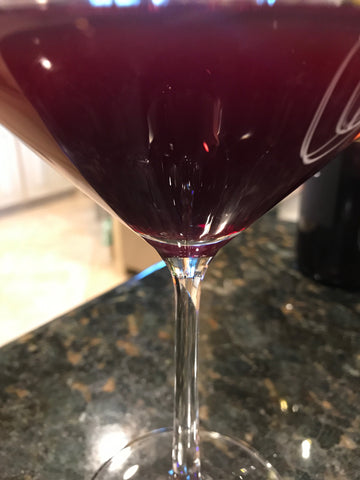
Wine drinkers eventually come across a wine that is not brilliantly clear in their glass.
Some may say,
“Ew, something is irregular here.” or “Yay, I’ve got a natural unfiltered bottle.”
This appearance of haze or sediment does not harm flavors. It is not dangerous. It is solely a visual thing. That is not a “bad” bottle.
If you age your wine for a day you may never see this.
But if you keep a collection of wines, like most wine drinkers do, you will most likely be seeing sediment and haze in older vintages.
As a wine ages in the bottle sediment will develop. When the bottle is handled sediment is suspended in the wine to create haze.
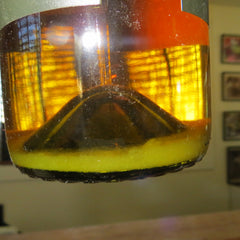 This is sediment in wine bottle.
This is sediment in wine bottle.
What’s going on?
During natural wine making wines become clear when ingredients that create turbidity fall with gravity to the bottom of a barrel. I call it “falling bright”. The clear wine is then decanted / racked off that sediment before bottling.
However, many wineries choose to process a wine further to assure that it will remain crystal clear under all conditions.
Fining is a process of adding a fining material to absorb, coagulate and strip elements from the wine that might affect clarity. This is filtered or falls to the bottom of the vessel and the decanting procedure is repeated.
Filtering is forcing the wine through a pad or membrane the catches particles.
A wine may also be centrifuged to spin out elements of substance.
All these processes are just for the sake of clarity. Clarity assures nothing more than a wine without haze and has little to do with overall quality, flavor or aroma.
When you alter a wine by removing components
you lose the qualities a wine possesses when it is whole.
Unprocessed wines are more flavorful, more complex and often age better.
But there is a chance a bottle may have sediment and display a haze.
This may freak out from folks. But now YOU know that haze is a sign of goodness. A sign that the wine is whole.
My wines are natural, but only a few exhibit haze. Best examples in recent years are 2016 Grenache and 2016 Grenache Blanc “Cuvèe Orange”. Interesting side note; a characteristic of Grenache as a variety is that it naturally tends to be turbid.
More about sediment in this Article.
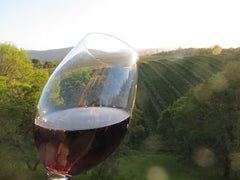 Cheers!
Cheers!
Weeds May 3, 2020 16:30
I've got my hands full. Cutting, pulling and chopping weeds is what I am doing.
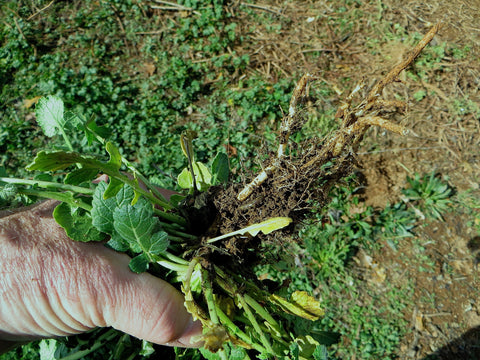
Each new year starts with cover crops, weeds and wildflowers that are allowed to flourish in the vineyard. The vines are dormant. The entire vineyard is green with plant growth.
In April I mow and plow in the cover crop leaving only the weeds in the vine row. Here is where the real work takes place. Controlling weeds between the vines is delicate tedious hand work. This is why many growers spray herbicide down the entire length of each vine row.
I don’t abide herbicide. I have chosen the tedious way instead.

This is a vine row with weeds that needs work.
The worst weeds are the ones that keep coming back even after all the chopping and weed whacking I do. After my first pass down a row the ground looks summer neat. But then some weeds grow back so I need to repeat the whole process of chopping and weed whacking. My dream is that doing the job just once would work.
Weed Overview
- Plantain is the worst. Keeps on coming back like a boomerang. They say you can eat the leaves and make past to put on skin, but I never have. Here it is growing under Mourvedre after the first pass 3 weeks ago.

- Filaree grows then dies, but leaves this twisty, sticky seed pod.

- Burr Clover grows then dies, but the burrs left behind are unpleasant and a real nuisance on dogs. It is a legume so they say it adds nitrogen to the soil. I think it may have inspired velcro.
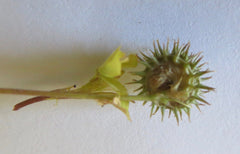
- Wild radish has pretty flowers and woody stems. Its flowers and seed pods are good to eat. I've eaten them, mildly spicy. Cut it down or pull it once and you are done.
- Wild Oats no problem. Pretty waving in the wind. Cut is once and it is gone for summer. It will be back next winter.
- Rattlesnake Grass is my ornamental favorite. I preserve small patches to enjoy seeing.

Contemplate any weed up close and you see beauty.
 Filaree
Filaree 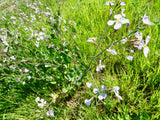 Wild Radish
Wild Radish
2019 - A Short Review. Fun, Flood, Fire, Fruit December 30, 2019 00:00
Fun
There are few things more enjoyable than working in vineyards, making wines in my cellar and visiting with guests on weekends in my tasting room. I am so lucky that this is what I do all year round. 2019 was no exception. This year was packed full of fun. Pruning, racking, bottling, harvesting, crushing, pressing, pouring samples of my finished wines for good people. This year I installed solar electricity. I was excited to release a pale direct press rosè. A red blend with 19% white grape. I got a truck load of aromatic oak barrels to play with. 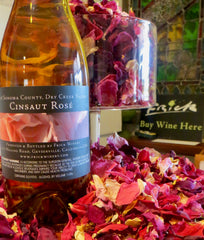

New Wine New Barrels
Flood
Last winter the rainy season started off slowly and late. Then it rained and then it rained a little more. Frick is located on high ground so the water soaked in, then the water flowed away. Lower points beyond flooded. Homes, vineyards and some wineries were inundated. But the soil reservoir was full and ready for vines to come out of hybernation. Season total rainfall here at Frick was 61.87 inches. Spring sprang green and lush.
Stream in Vineyard Rain gauge overflowed
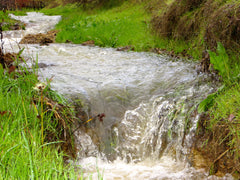

Fire All is OK and safe with the people, vines and wines here at Frick. Here is the story.
October is the month to wrap up harvest and get ready for winter. It has also become wildfire season. Jobs must be scheduled around planned power outages that are meant to protect us from fires.
One of those power outages began on October 21. In the darkness the following morning I smelled smoke grabbed a flashlight. Outside it was warm silent and windless as the light beam cut through thick clouds of smoke to illuminate falling ash. This is now known as the Kincaid Fire. The fire spread. That power outage was prolonged. Mechanized winery jobs were on hold. I was out of communication for many days. Prevailing winds away from here enabled my vineyard to escape smoke damage. Evacuation became extensive and long. During this time, I was able to be here and personally attend to my wines and vines every day, except for one.
October was a trying month.


The fire Dinner by candlelight
Fruit
Fruit makes the wine. Last spring bud break was 2 weeks late. Last rains of the season were late. All varieties except Viognier escaped late rain washing away pollen. Good late season rainfall meant the vines grew vigorously through spring and summer. Weeds in the vineyards also grew vigorously so the winemaker worked vigorously hoeing weeds all summer. Harvest was late and ran from early September to early November. During harvest I worked around loss of power, but in the end it did no harm to the fruit. Yield quantity was normal. Grapes were delicious with excellent acid balance. Young wines are now going into barrels to sleep, age and mellow for 22 month into complexity.

2019 was a memorable year. It will be a delight to savor the wines from this vintage. Just going to have to wait two more years. BUT you can enjoy some 2016 and 2017 right now.
Rocks August 17, 2019 07:00
I like rocks. I like things older than me.
When I look at a rock I imagine how it may have been here before human beings walked the earth. Rocks are nearly eternal.

I accumulate rocks. Pick them up and put them in my pocket, then unload them in a bowl. After the bowl is full I admire them for a while then scatter them back in the vineyard. Catch and release rock collecting.
Rocks are in my vineyards. I have licked rocks. Perhaps you have too. Some are sweet some are salty. You can taste them in my wine. I know that this is not logical but I feel that I can taste them. Sometimes feeling is better than knowing.
In the vineyard rocks offer visual interest. A smooth bolder here, gravel there to punctuate the soil.









The physical properties of rocks keep clay from clotting. Rocks don’t hold water, but they do help the movement of water through the ground. Vine roots cozy up against rocks for the water that flows along their hard surface.

Without rocks lizards wouldn't have the perfect stage to collect heat from the sun.

If there were no rocks in the vineyard we would not hear the musical clanging of steel harrow discs against them during plowing.
I would have nothing of substance to throw at a marauding crow.
Marking a location in the vineyard would not be so elegantly simple.

Rocks are fixtures in my vineyard. A beautiful reminder of our place in the cosmos.

This is my most rocky wine right now.
Mourvedre is an earthy wine.See more about it here
Dog Days of Summer July 11, 2019 10:30
We will get through these long hot days. We always do.
My wines would not be so good without them.
Dog Days means hot and humid in many places. But here In Dry Creek Valley July days can start gray with cool foggy dew on the vines. Afternoon humidity is low.

A typical foggy morning.
Heat arrives around noon after the fog burns off. Bright sunlight begins heating things up in late morning and escalates to a peak around 4.

Temperature rarely rises above 100F. But when It does fog soon rolls in to moderate.
After a cool night vines begin the day fresh with turgor. Perky and upright they lean toward the sun to absorb sunlight in order to mature their grapes.

As the sun disappears in the west vines have become a little worn after a full day of low humidity and sunlight. Canes hang and leaves temporarily wilted are ready to have 10 hours to restore before their work begins again.
In July comes the first clue of ripening. Veraison (change of color in the grape berries). Grapes bunches will rapidly turn from green to purple.

Veraison. Another magical time the vines.
Vineyard jobs like mowing, plowing, weed whacking, cane positioning have slacked off.
Walks thought he vines still requires little corrections like positioning canes and pulling leaves, but for the winemaker there is time for an occasional afternoon rest.

It's just a short siesta on the
tasting room porch.
Inside the winery the job is getting my 2017 vintage ready to bottle by moving wine out of the small oak casks where it has been aging for the past two years.
I reside inside the cool tasting room three days a week now for summer hours. Friday, Saturday and Sunday. Folks on vacation are visiting from all over the world. When I see a familiar face returning to buy my wine I am happy and thankful for such a wonderful group of customers.
We owe the term Dog Days of Summer to the brightest star in the July sky, Sirius. As the prominent star in constellation Canis Major it is a stand out. Sirius is twice as big as our sun.


Water is life. I irrigate when needed. But I am judicious about it's use. Now monitoring is important in the vineyards. I am constantly checking for leaks, clogs and places where porcupine and coyote have chewed the drip lines
Summer Solstice Reflections June 19, 2019 13:00
Friday June 21, Summer Solstice, marks the onset of summer.This is a special day.

On this longest day, sunrise is 5:45am. But by 5:15am twilight is enough to see things. Dragging this body out of bed early is not my greatest pleasure. But once up and moving around in the vineyard magic begins. Bobcats and coyotes use the last minutes before dawn to get back to their lairs. The air smells so cool and fresh that is has substance. Crows and Jays have not started getting into mischief. No frantic chirping. A definite silence surrounds me. Light begins flowing this direction from the eastern horizon. As color slowly appears in the vines and trees I feel like I am the only human being on earth.

This day will be long in terms of sunlight. Almost 15 hours of daylight. The last rays of the sun will still be shining over the western horizon until nearly 9pm. Now as days get progressively shorter the vines begin a race to ripen fruit for harvest before there is too little sunlight and the rainy season begins.
Grape clusters are currently bb sized berries. Vines require sunlight, heat and time to produce the correct kind of ripe, juicy, sweet fruit for wine. Today begins the long haul through summer towards harvest. It will be three more months before Counoise and Mourvèdre are ready. The summertime job pulling leaves and thinning clusters of fruit to create a vine environment with balance of sun, shade and air is prime. An airy well-lit canopy of green is best to ripen flavorful purple grapes.

Summer nights on the vineyard are for cooking on the outdoor grill; chicken, corn, ribs, eggplant, squash. Drinking chilled Cinsaut with chicken dinner. Moonlight swims. Gazing with awe at the twinkling visible universe in the night sky; then counting satellites.

The tasting room is open Summer Hours. I added Fridays to Saturday and Sunday. This will accommodate more people who are out and about. It is really nice to be able to show visitors the wines that are grown here.

The other 4 days of the week will be spent alone in the vineyard thinning canes and leaves, weed whacking, hoeing weeds, inspecting vines for signs of water stress. Or inside the cool winery working with topping, tasting, blending and bottling.


The green vines march over Owl Hill. Here with summer weather grape berries will grow plump and change color from green to purple (veraison).

Before we know it autumn and harvest will be here.

7.77 acres and a man
Bees and Flowering Grapevines May 20, 2019 13:25
I see an abundance of bees around the vineyard daily.Honey bees and bumble bees are the most common.
They are busy collecting and scattering pollen everywhere.

They particularly love lavender, rosemary and wild weed flowers.
I rely on them to pollinate my fruit trees.I love the bees, but I do not need them to pollinate my grapes.

My different varieties bloom at different times. Viognier is first and is now in bloom. Later comes Counoise and Mourvèdre with most buds now still tight.

Out of the buds appear small white flowers.
These tiny flowers are self-contained pollinators
that have both male and female parts.

Gravity or a wisp of wind is enough to pollinate a grape.
Bees are not needed to carry the pollen.
Good thing because these little flowers do not attract bees.
In a little over 3 ½ months a sweet ripe cluster will be ready for harvest like this Counoise.

There is an issue this year. Late rains. An unusual series of storm fronts have been dropping down here from Alaska. These fronts have been extra wet. Rainfall has been ongoing with significant heavy downpours.
Vines that are blooming now are at risk of having pollen washed away before it can do its job. Berries that don't get pollinated are called "shot" berries as seen in the cluster below. This really affects the yield at harvest.

On the bright side. The storm fronts have also been cold.
The cool temperature has delayed some flowering.
I will just have to wait and see how these May storms have affected pollination
and grape yields this vintage.
But one thing is for sure, bees had nothing to do with it.
Spring has Sprung at Frick May 1, 2019 16:42
May 1, 2019
The 2019 growing season has begun.
The vines and I are off and running.
 Rain gauge overflowed often.
Rain gauge overflowed often.It was a long winter with over 57” of rainfall here.
Cold wet storms continued well into March.
Cold and rainy weather kept vines dormant for
a delayed but break. Ground in the vineyard was so
wet that cultivation was delayed until just now.
 Owl Hill Vineyard
Owl Hill VineyardBecause of an abundance of moisture in the soil
and the sudden spring heat spell in April vines burst into life.
They quickly budded and started growing inches each day.
There has been no spring frost. Always a good thing.

Now all my vines have beautiful fresh young green leaves
seen in Gannon Vineyard above.
Fruit clusters are big and plump.
Growth continues with noticeable lengthening of canes every day.
Vine varieties are not all the same.
They start growing at different times.
Viognier and Carignane are early.
Mourvedre and Counoise are later.
Some sections of the vineyard have much more growth than others.
Different variety characteristics make for interesting farming.


Above-Carignane Above- Mourvèdre
The tall, well-watered cover crop was, finally, just mowed and plowed in for some wonderful tilth.
The tractor did not get stuck in wet spots.

Below you see my main piece of equipment.
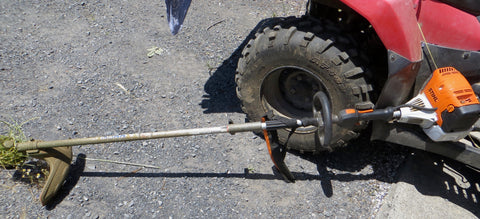
I have started weed-whacking and chopping extra thick growth of grass in vine rows.
There is a lot of extra clearing work ahead of me this year.
Maybe I will receive another Certificate of Excellence for 2019.

Vineyard Cover Crop January 21, 2019 22:27

Winter Time
All the leaves are gone and the vines stand bare
like woody sculptures.

But there is something green out there.
It is this Cover Crop.
This is how it as it looks right now in January.
It will often grow to be nearly 4 feet high.

These are the organic seeds. A blend of peas,
fava beans, barley and oats.
To improve the health of my vineyards
I introduced a yearly cover crop.
It builds tilth in my rocky soil. It develops a spongy
top soil that will retain rain water longer into summer.

The cover crop is food for many earthworms that nourish the soil.
Tons of additional organic matter, plowed in,
increases the volume of top soil.
Legumes release nitrogen to be available to vine’s roots.

A healthy vineyard means beautiful grapes,
a happy winemaker and delicious wines.
How I Do It.
In the fall.
I soften the soil by plowing with a disc harrow.

Then I drill the seeds.
Wait for rain to germinate the seeds and
let the cover crop grow all winter until April
when it is big and tall.
In the spring
I mow down the cover crop and
mix the organic matter into the soil with Disc.
Then I've got some nice dirt for my grapevines.
Normally I need to mow down the cover crop before the legumes
and grains ripen. But occasionally timing allows me to be able to pick some favas. I enjoy them as a nice fava bean salad with a glass of cinsaut.

Simple Definition of Natural Wine August 20, 2018 10:19
Until recently “wine” and “natural wine” were the same. Then that changed with increasing technology, winemakers interested in manipulation and companies looking to expand their winemaking product lines.
“Natural Wine”, what does this term mean?It means fermented grape juice.

Here is my red wine recipe:
- Start with really good fresh ripe grapes.
- Break or crush the skins to get juice.
- Put this into a vessel.
- Add a little natural yeast.
- Ferment until done.
- Remove the liquid wine from skins.
- Clarify and age the wine in small oak barrels for 22 months.
- Put wine in bottle and cork it.

Otherwise it can get complicated. Wine can be manipulated and altered
by adding things that are bought commercially and not naturally found in grape juice or wine, like microbial control agents and:
artificial enzymes 
artificial tannins
yeast nutrients
fining materials
 Pile of tannins
Pile of tannins
Or by using industrial manipulation like:
centrifuges

filtration

reverse osmosis
Wine is a wonderful thing.
Manipulations are not all bad. They can have their place.
They can work to correct problems and make a wine approachable. For example, most folks would think a bottle of wine they bought at the supermarket was ruined or foul if they saw sediment in the bottle. Manipulations will eliminate sediment. (Although WE know sediment is indication of a superior wine. See Sediment Blog about this.)
I prefer not to alter or manipulate the beautiful perfect grapes I grow.
Fundamentally I find that I enjoy things most when they are
made naturally and simply. Like wine. Like bread baked from only flour, water, yeast, salt. Cheese made with whole unpasteurized milk, rennet, salt.
Nothing more, nothing less than is needed. It's simply natural.
I Like Sediment April 21, 2018 10:02
Wine Sediment. You won't find it all the time, but when you do consider yourself lucky.
A Dictionary definition of sediment: “Matter that settles to the bottom of liquid.”
You will find sediment in wine because wine is a liquid containing matter. Delicious matter. If a wine is not industrially processed natural tannins, acids, tartrates and pigments can sometimes settle and appear on the bottom and sides of a bottle and on the cork.

When wineries process their wines to strip out sediment the character of the wine is diminished. But processing is done anyhow because of fear that their customers will reject a wine that has sediment.
I prefer to embrace the integrity of a whole natural wine. I eschew processing, so that all of a grapes tasty elements remain. When you hear terms like unfiltered and unfined, this is indication that a wine is not processed.
 Sediment in white wine may be tartaric crystals as you see on this cork or in bottom of the bottle. Sometimes a small amount of powdery white sediment settles.
Sediment in white wine may be tartaric crystals as you see on this cork or in bottom of the bottle. Sometimes a small amount of powdery white sediment settles.
The places to find red wine sediment are on the cork, adhering to the bottle wall or loose on the bottom.

The wine itself is always clear unless you shake the bottle.
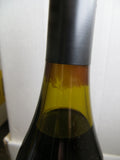 Sediment is a perfectly harmless indication that you have a good natural bottle of wine. Here you see sediment stuck to the inside of a bottle.
Sediment is a perfectly harmless indication that you have a good natural bottle of wine. Here you see sediment stuck to the inside of a bottle.

The article below tells more of the story.

SPELLING BEE - Cinsaut or Cinsault March 1, 2018 09:52
Spell "Sahn-so"
I am confounded as to why I am seeing more spelling with an "L" as in Cinsault on wine labels. Nothing totally wrong with that because it is the spelling in some counties. I even occasionaly slip the "L" in there myself. Except when it comes to American wine labels we are told to skip the "L". Regulations in the USA stipulate that the spelling be without the "L" as Cinsaut.
This I learned 27 years ago. Below you see the label for my first cinsaut bottling. It was sent to Washington DC for approval (all wine labels require a federal label approval) and was rejected because of the spelling Cinsault. I had already printed the labels and luckily received a one-time use dispensation, but I was told to never use this spelling again. I have not. The regulation sited is that a wine varietal label using this grape name must be spelled cinsaut.

On every label since I comply and use "cinsaut" based on that regulation. Every wine, before it can be sold in this country, must receive a certification of label approval. I prefer getting my labels approved, not rejected.
There is a comprehensive list of all approved grape variety spellings. The list below shows the section of that list that includes cinsaut. The logic is that spellings need to be consistent in order to standardize a name so that consumers know what they are getting. When you have too many synonyms it will be confusing in the marketplace. Here are just a few of the synonyms: Cinsaut, Black Malvoisie, Cinsault, Chainette, Cincout, Cinq Sao, Ottavianello, Picardan noir, Cinquien, Cinsanet, Sinsó, Black Prince..
The List


Winter Is Always About Pruning February 5, 2018 08:00

Soon we will be finished, just in time for spring.
This most important job is done only once a year when the leaves have
fallen and the skies are grey.
Chances are all the folks you see out in the vines this time of year are doing pruning.
Every single vine in every vineyard gets pruned.

This coming vintage will be determined by the remaining buds.
Pruning directs how the vine will grow and how many grape clusters a vines will set.
 The goal is one or two buds per spur
The goal is one or two buds per spur
depending on the size and age of a vine.
If you don’t prune you end up with a large rangy vine
with numerous small clusters of grapes that don’t get fully ripe.

Here canes removed from the vines are chopped up and plowed into the soil to build humus.
Some are saved to fuel and flavor summer grilling.
Orange Wine August 24, 2017 15:26
It is called Orange wine because it is orange in color. It is a different kind of wine made from white grapes, just like rose is a different kind of wine made from red grapes. Orange wines are gaining in cult popularity, but will never be main-stream. They are controversial because most people are not accustomed to white wine with tannin. Not everybody's expected glass of wine. Those who love it and enjoy successful pairings are big advocates. Great to use when experimenting with food pairings. Goes great with rich foods just like a red wine.
Orange wine has a been around in eastern and central Europe for a thousand years. Imagine enjoying a home made meal and wine with a family in the country side of Georgia. Made with an ancient method in which white grapes are not separated from the skins before fermentation. This gives the orange wine color, complex flavors and pulls tannins from the skins that imparts a red-wine-like body.

I make my version of Orange wine with Estate Owl Hill Vineyard Genache Blanc grapes. I chose this grape because it is naturally amber in color.

Grenache Blanc juice and skins foam and ferment together for over a week. The bright color indicates that fermentation is going well.

A new unique and magical orange colored wine flows from the fermenter.

I call my wine Cuvèe Orange.

Tasting Notes: Orange color. Mysterious aromas of caramelized pear, orange zest, cashew butter and spice. Deep flavors of dried mango, kiwi, key lime, gooseberry, vanilla, touch of fresh peach pie. Earthy mineral and dry tannin finish.
Orange wine pairs well the a wide variety of foods. Curry, roast turkey, ham, tajine, pork chops, Korean BBQ, natto, chicken liver pate, squab, eggplant parmesan, sweetbreads, poached salmon, mushrooms, spiced butternut squash, game birds
See more and buy it here: FRICKWINESTORE
What I Know About Counoise July 30, 2017 19:06
Counoise is originally from the Southern Rhône. The clone I grow is from the vineyards at Château de Beaucastel.
Part of what I know about Counoise was gleaned from readings, readily available to anyone interested. So this discussion is based solely on my personal experience with the grape variety.
Research indicated that it would grow well here in the terroir of my hillside. I tasted counoise wines that spoke of their character and heritage. They were interesting and delicious. I’ve had success with Cinsaut. Cinsaut & Counoise have similarities like large juicy berries and a love of heat.
So I planted counoise at the top of Estate Owl Hill Vineyard.
 This section of the vineyard is rough & rocky with two microclimates. The warmer section, 65% of the total vineyard, is hot with long full day sunlight.
This section of the vineyard is rough & rocky with two microclimates. The warmer section, 65% of the total vineyard, is hot with long full day sunlight.

The other 35% has late afternoon shade and cooler temperature. The sun builds the sugar and rich fruit, the shade contributes savory refreshing natural acidity.
The vines are not vigorous with chubby, pink, upright canes.
They are late to bud, bloom and ripen. Of the 8 Rhône varieties I grow counoise is the last to ripen. The plump berries are a beautiful reminder of grape motifs from ancient ruins.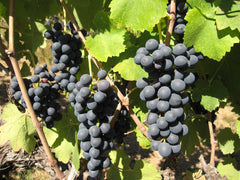
The wine has flavors of earthy blueberry and black currant.Luxardo Maraschino cherries, savory marzipan, fresh prune, black fig and vanilla.
Pairs deliciously with many foods. Drink with pizza, Moroccan spiced chicken, eggplant roasted until creamy, duck confit, crisp garlic bread sticks, juicy pork belly, pasta with peas, vegetable soup, California teleme cheese
Pronounce counoise as "coon-whaz"
More about Counoise 2014 and purchasing information can be found HERE
Killer Heat Wave June 19, 2017 12:07
Growing grapes has a lot to do with weather. Here in Dry Creek Valley we have near perfect weather for growing excellent world class wines. But weather charts its own course.
 This week we are having 5 consecutive days of 101F+ weather. Some days as high as 108F.
This week we are having 5 consecutive days of 101F+ weather. Some days as high as 108F.
There is going to be some damage before the fog rolls in this weekend. Most of the established vines will weather this extreme. But I am watching the 2 acres that I budded earlier this year The new buds and their growth is tender and susceptible to what is going on. On my vineyard walk this morning there were already some totally welted and burned growth. I am afraid the “take”, new buds that survive, will not be where it would have been without this heatwave.
 This is tender young bud grown.
This is tender young bud grown.
There is no changing the weather so as a grape grower you know to take the good with the bad. This period of extreme heat is not going to hurt the 2017 vintage, but it will kill some young vines.
Winter in Frick Vineyards January 11, 2017 08:59
Days are short and often gray. This season the storm door has been open. Rainfall to date (January 11, 2017) is 201% of normal. All lakes and ponds here in Northern Sonoma County are at capacity with water rushing down spillways into full flowing creeks.
Frick Crick is flowing and Frick Fall is cascading.


What to do on a day like today but stay dry and write a blog.
The rain is needed. We have seen so many back to back drought years that all this water is making me giddy. Everyday the grass gets greener. The vines are going to love having this water to drink when they wake from their dormancy.
In the vineyards all the leaves are gone. The activity you will see in the vineyards is pruning. It has begun in the periods between rainstorms. Pruning is the biggest and most important job this winter because it is setting up the vines for the entire 2017 growing season.
 There are few things in life that more pleasurable than pruning grapevines. In the middle of a vine year after year it becomes very familiar and a good friend.
There are few things in life that more pleasurable than pruning grapevines. In the middle of a vine year after year it becomes very familiar and a good friend.
The process of pruning is assure that you will get good wine from the vine. Each cane is cut back to just 2 buds. Next harvest each bud will yield 2 bunches of grapes.

Perfectly pruned old vines. A beautiful winter sight here in Garibaldi Vineyard.
Blends November 29, 2016 09:57
MIXING IT UP – WINE BLENDS
Blends dominated before varietals were introduced in the 1960’s Now they are coming back into popularity in the USA.
Varietals are a delightful pure expression of a grape variety. Blends are often the expression of the winemaker that go beyond the characteristics of one grape. Blends are not better nor worse than varietals, just different.
Three ways of creating a blend.
1. A Cellar Blend is made in the winery. Different varieties are first made into a 100% varietal wine. A varietal wine is then mixed with others by the winemaker to create the blend. The winemaker is in control There are no restriction on what varieties or how much go into a blend. Different formulas are mixed in the lab and then tasted to see what is the BEST. Examples of my cellar blends are Cotes-du-Dry Creek, Lucia, C2 & C3. Understanding the characteristics of my 8 grape varieties I put them together in a way that they will contrast and compliment. Fruit with tannin. Earth with acidity. Leanness with richness.
 The process of creating a cellar blend. Each glass contains a different percentages of the base wines.
The process of creating a cellar blend. Each glass contains a different percentages of the base wines.
2. A field blend is made in the vineyard (field). It is created by planting different varieties mixed together in the same vineyard plot. This was the common way to grow wine 100 years ago. All varieties are handled the same, harvested together and ferment together so you have many grape varieties, one wine. Example of my field blend is Garibaldi.
 Freshly harvested GARIBALDI. 10 grape varieties (red & white) are in this bin.
Freshly harvested GARIBALDI. 10 grape varieties (red & white) are in this bin.
3. In a Co-fermented Blend different varieties are harvested separately from their individual vineyards then brought to the winery, crushed and in the winery fermented together. I do not use this technique because my varieties do not ripen at the same time.
 COTES-DU-DRY CREEK, my signature blend comes as RED and WHITE wine.
COTES-DU-DRY CREEK, my signature blend comes as RED and WHITE wine.
Brix October 2, 2016 10:52
Degrees Brix is a unit of measure indicating amount of sugar in grape juice or other solution.
In winemaking it is a tool in determining grape ripeness and when to harvest.
Brix is also the name of some restaurants and wine shops because it is cool sounding common winemaking word.
Named after creator Adolf Brix, it is a good indicator of sugar level and therefore helps determine the ripeness of a grape. One degree Brix is approximately one percent sugar.
Brix is handy for grape growers and winemakers because it is a fast and easy test using a portable hand held refractometer.
After tasting grapes in the vineyard I use a refractometer to monitor ripeness.

Typically grapes are harvested in the range of 22 to 27 degrees Brix. 22 is marginally ripe and usually ferments a lower alchohol wine (around 13%). 27 is very ripe and will ferment a higher alchohol wine (possibly 16-17%). Individual winemakers prefer different degrees of ripeness based on the style of wine they want.
To decide when to harvest, in addition to Brix to determine ripeness I also pay attention to appearance of the berries, flavors in the juice, acids, color of the seeds and flavors in the skins. For me balance is the key to perfect ripeness.
This is what a perfectly ripe cluster of Viognier looks like. Translucent (you can see the seed inside) and glossy rich color. This grape tested 24 degrees Brix.

- Page 1 of 2
- Next







